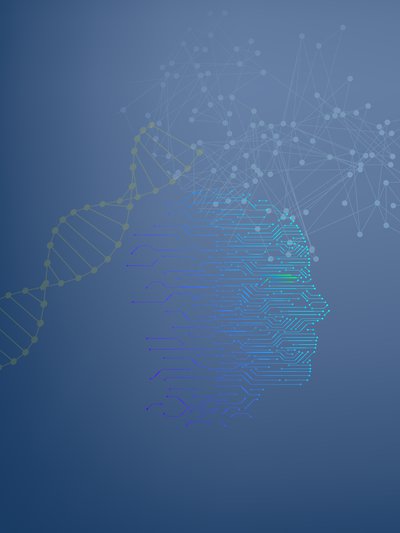



Toward the Algorithmic Age
Virtual AIHce EXP 2021 Prepares Attendees for OEHS in Transformation
BY ED RUTKOWSKI AND KAY BECHTOLD
AIHce EXP 2021 was originally planned to be a hybrid event with a face-to-face component held in Dallas, Texas, and a virtual one for a live online audience. But due to the slow rollout of COVID-19 vaccines early this year, many members expressed reluctance to travel and many others indicated that their companies had implemented travel restrictions. For these reasons, AIHA announced in March that the conference would be held entirely online.
Comprising a mix of prerecorded presentations and live virtual sessions, AIHce EXP 2021 launched in late May to an audience that eventually exceeded 2,500 attendees. Despite some technical issues with the conference platform, the sessions garnered high praise on conference evaluations for their technical content and relevance. This article presents excerpts from Synergist coverage of select AIHce sessions and directs readers to where they can read the full articles online.
LEADERSHIP ON THE FRONT LINES
His friend Chris was lying in a pool of blood, his eyes fixed and dilated. Dr. Sudip Bose listened for a heartbeat, heard none, and declared him dead. The next patient, the man who killed Chris, was brought in screaming and kicking; he didn’t want Dr. Bose’s care any more than Dr. Bose wanted to provide it. But that was his duty as an Army doctor on the front lines of Iraq, a duty he somehow found the mental fortitude to perform.
This harrowing anecdote from the Iraq War was one of several Dr. Bose shared during the AIHce EXP 2021 Opening Keynote on May 24. Perhaps best known as the man who treated Saddam Hussein following his capture by United States forces in December 2003, Dr. Bose would eventually receive the bronze star for serving one of the longest continuous tours by a U.S. Army physician since World War II. During his presentation, Dr. Bose turned his wartime experiences into lessons on how to handle extreme stress that attendees could apply in their lives and careers. Read more.
AIHA FELLOWS DEBATE "THE TOTALS"
Members of AIHA’s Fellows Special Interest Group offered varied and at times clashing perspectives on a key issue facing the OEHS profession: to what extent should workplace health protection programs attempt to address health issues outside the workplace? The live session held on May 24 continued the annual AIHce tradition of AIHA Fellow debates, during which recipients of AIHA’s Fellow Award present opposing arguments on controversial topics.
As explained in a brief introductory statement by Fellows SIG Chair Jennifer Sahmel, this year’s debate would address the recent trend in OEHS activities toward engagement with worker health problems that can arise from non-occupational concerns such as diet or smoking as well as psychosocial stressors and issues related to workplace leadership, compensation, benefits, and policies. NIOSH has formalized these concerns in its Total Worker Health (TWH) program, which the agency describes as a “holistic approach to worker well-being.” A related approach known as Total Exposure Health (TEH) draws on sciences such as genomics and data-gathering technologies to attempt to understand the totality of each individual worker’s exposures both at work and at home. TWH and TEH, as well as a narrower approach called Total Worker Exposure (TWE), are collectively known as “the totals” among OEHS professionals who use aspects of these frameworks.
While no judges were present at the debate and no winner was declared, most attendees’ comments in the chat were pro-totals. Still, some commenters expressed unease regarding potential infringements on workers’ privacy and acknowledged that data security is vital to the success of these programs. Read more.
HOW CAN IHS HELP SCHOOLS?
As school districts across the U.S. plan to resume large-scale face-to-face learning this autumn, a special panel joined Virtual AIHce EXP 2021 on May 24 for a live discussion of the roles industrial hygienists can play in reopening schools and the barriers that could prevent success. The panel included Tracy Washington Enger, a program manager with EPA’s Indoor Environments Division who has extensive experience working with school administrators; Devin Jopp, CEO of the Association for Professionals in Infection Control and Epidemiology; and Alex LeBeau, a toxicologist and industrial hygienist who owns a consultancy in Orlando, Florida, and a contributor to AIHA’s Back to Work Safely documents. Read more.

AIHce EXP 2022 is scheduled to be held in Nashville, Tennessee, May 23–25.
SINCLAIR LECTURE: THE PANDEMIC IN THE MEATPACKING INDUSTRY
Journalists Rachel Axon of USA TODAY and Sky Chadde of the Midwest Center for Investigative Reporting appeared at Virtual AIHce EXP 2021 on the afternoon of May 24 to share the story of meatpacking workers who bore the brunt of the COVID-19 pandemic as plant executives “sacrificed safety for profits.” Their talk was part of the annual Upton Sinclair Memorial Lecture series, which highlights the importance of media in occupational safety and health.
As the COVID-19 pandemic spread across the U.S. in spring 2020, Axon and Chadde were part of a team of journalists who initially sought to report on meat shortages at grocery stores. The meatpacking industry—including large companies like Tyson, Smithfield, and JBS—was warning that supply chain disruptions could mean that there wouldn’t be enough meat for people to put on their tables. Meat shortage fears combined with lobbying from the industry led former President Trump to sign an executive order on April 28 invoking the Defense Production Act to ensure that meat and poultry processing facilities would remain open during the COVID-19 pandemic, despite outbreaks of disease at several plants across the country. But the U.S. was never in danger of a meat shortage, reporters found; the industry exported more meat in 2020 than it did in 2019. That’s when the focus of their story shifted to worker safety. Read more.
HOW A MAJOR RETAILER PROTECTED WORKERS
The first documented case of COVID-19 arrived in the U.S. on Jan. 21, 2020. Two weeks later, on Feb. 3, the U.S. declared a public health emergency. Around the time the World Health Organization officially declared a pandemic on March 11, most U.S. retailers had wholly or partially shut down.
Like many OEHS professionals, Benjamin Chandler felt that the rapid chain of events had put him on his heels. A board-certified industrial hygienist with GHD in Little Rock, Arkansas, Chandler provided EHS consulting services to a major retailer with a large geographic footprint whose business included pharmacies and optical centers, many of which were now closed. These facilities were vital sources of medications and healthcare services in communities across the country. It was Chandler’s responsibility to get them reopened safely. Read more.
NIOSH PRESENTERS TALK WORKPLACE COVID-19 VACCINATION
Leaders of the Essential Workers Team in CDC’s Vaccine Task Force provided an update on workplace COVID-19 vaccination during a session that aired on May 25. The NIOSH team also discussed the agency’s response to the COVID-19 pandemic as well as field and virtual assistance that NIOSH has provided directly to employers and other jurisdictions.
Following CDC’s release of new interim public health recommendations for fully vaccinated people on May 13, many OEHS professionals who attended the session were understandably interested in vaccine-related developments from NIOSH. According to CDC’s new guidance, fully vaccinated people no longer need to wear a mask or socially distance in any setting, except where required by laws, rules, and regulations, including workplace guidance. Read more.
PROTECTING MINORITIES DURING COVID-19
On Feb. 23, 2020, Ahmaud Arbery, a Black man, was shot to death as he jogged near his Georgia home by a white gunman. A few weeks later, much of the U.S. economy shut down due to concerns about COVID-19, which the World Health Organization declared a pandemic on March 11. On March 13, Breonna Taylor, a Black medical worker in Louisville, Kentucky, was killed in a botched police raid. In the months afterward, misinformation about the pandemic led to racist and xenophobic attacks against Asian Americans. COVID-19 case numbers swelled, with hospitalizations and deaths disproportionately affecting Black, Hispanic, and Native American people. Then, on May 25, George Floyd was murdered in Minneapolis, setting off protests across the country.
As the country’s racial reckoning and public health crisis lurched along side by side, members of AIHA’s Women in IH Special Interest Group—including Subena Colligan, Jennifer Hsu, and Ivory Iheanacho—were discussing the effects of COVID-19 on minority communities, and they decided it was time to act. The group started a collaboration with AIHA’s Social Concerns Committee and Minority Special Interest Group intended to raise awareness of issues of race and the pandemic among OEHS professionals. One outcome of this collaboration is the AIHA guidance document “The Lens of Minority Populations in the Workplace During COVID-19,” which was published in December. Read more.
HOW A HOSPITAL WEATHERED THE PPE SHORTAGE
When Dr. Devon Hahn heard about the coronavirus spreading through Wuhan, China, in late 2019, her first reaction was professional curiosity. A pediatrician and assistant professor at the University of Oklahoma’s Health Sciences Center in Oklahoma City, she knew that several strains of coronavirus cause bronchiolitis in infants, which is the number one reason that babies are admitted to hospital. “Medically speaking, we talk about coronaviruses all the time,” Dr. Hahn said in a recorded presentation. “Hearing about a coronavirus that has different effects on humans was, at first, interesting—and then it became terrifying.”
The first COVID-19 patients were admitted to OU HSC in late spring 2020. Staff didn’t know what to expect. They were instructed to wear full PPE for long periods of time. “We weren’t even sure how it was being transmitted,” Dr. Hahn said. “Our lives became gowns, gloves, goggles, and N95s.”
OU’s approach to the N95 shortage was to develop alternative PPE, adopt CDC guidance for the extended use and reuse of PPE, and decontaminate N95s using in-house techniques. This approach helped preserve limited supplies but caused concern among OU doctors, Dr. Hahn said, who worried they were putting patients and staff at risk. In addition, the logistics of decontamination proved complicated. Staff were required to put their devices in envelopes at the end of their shift, to be sent off for decontamination. When the decontaminated respirators were returned, staff had to search for their own devices. “The whole system was very clunky,” Dr. Hahn said. Read more.
LESSONS LEARNED FROM CATASTROPHE
On April 15, 2020, a rupture in a pressure vessel at a paper mill in Jay, Maine, caused an explosion that spewed wood pulp and other materials around the site and outside the fence line. When Sarah Anderson arrived the next day to help direct cleanup efforts, she found a scene of devastation: mangled equipment, scattered debris, and unstable structures. The incident caused no injuries or deaths, but the seven-month cleanup presented significant challenges. Drawing on her 25 years of experience in the oil, gas, petrochemical, and manufacturing industries, Anderson distilled her experiences into practical lessons for other OEHS professionals who find themselves in the demanding role of responding to a catastrophic event.
“When you arrive on site and you see something like this,” Anderson said, showing images of the wrecked facility, “how do you even start?”
The place to start, in this and most emergency situations, is with securing the scene. “People are very inspired to get operations back up and running,” Anderson said, but they may inadvertently disturb evidence needed for an investigation or put themselves in harm’s way. This motivation to help may have been even more pronounced in Jay, a town of 5,000 about 30 miles northwest of Augusta, Maine’s capitol. Many of the mill’s 500 employees were residents of Jay, and the close-knit community was heavily invested in getting the facility operational again. Read more.
OSHA INTRODUCES "SAMPLING GROUPS"
Three representatives from OSHA’s Salt Lake Technical Center (SLTC) discussed the agency’s efforts to update methods for industrial hygiene sampling and laboratory analysis in a recorded presentation. According to Phil Smith, director of the Division of Industrial Hygiene Chemistry at SLTC, the updates will benefit both field industrial hygienists and the labs that analyze IH samples by ensuring consistent procedures are used across laboratories for several of OSHA’s most used methods.
As part of its update, OSHA has created several “sampling groups”—aggregates of multiple analytes that can be sampled and analyzed by the same method. To illustrate sampling groups, Smith and Daren Pearce, a chemist with SLTC, explained the development of OSHA Method 5000 for organic vapors such as benzene, n-hexane, isobutyl acetate, and others. Method 5000 replaces Method 7, which the agency has withdrawn.
As written, Method 7—collection on charcoal, extraction with an organic solvent, and analysis by gas chromatography with a flame ionization detector—can apply to more than 70 substances. Laboratories often had to modify the method to obtain data on the wide variety of analytes submitted by their IH customers, Smith said. These modifications differed across laboratories, complicating attempts to compare results; sometimes, even chemists within the same laboratory would use different procedures under the auspices of Method 7. Read more.
OEHS IN THE ALGORITHMIC AGE
New technology developed in response to the COVID-19 pandemic will forever change the design of workplaces and the way people practice occupational health, futurist and keynote speaker Mike Walsh told the virtual audience of AIHce EXP 2021 during the conference’s closing session. Walsh’s presentation provided insights on how industrial hygienists and occupational and environmental health and safety professionals can navigate accelerating technological change and prepare for a new future of work. He stressed the importance of people and behavior to the future of all industries, especially OEHS, and urged organizations and leaders to be ready to transform in order to survive in what Walsh terms the “Algorithmic Age” of artificial intelligence (AI), algorithms, and automation. According to Walsh, AI will change the way products and services are designed, which will have an “extraordinary and profound effect” on the nature of work itself.
“The workplaces we’re going to have to prepare for in the future [and] the kind of hazards and safe environments that we now need to design are going to be very different from a few years prior,” Walsh said. “Platform-based businesses that are built on data, AI, and automation [will] require [safety] professionals who think in very different ways.” Read more.
ED RUTKOWSKI is editor-in-chief of The Synergist.
KAY BECHTOLD is managing editor of The Synergist.
Send feedback to The Synergist.